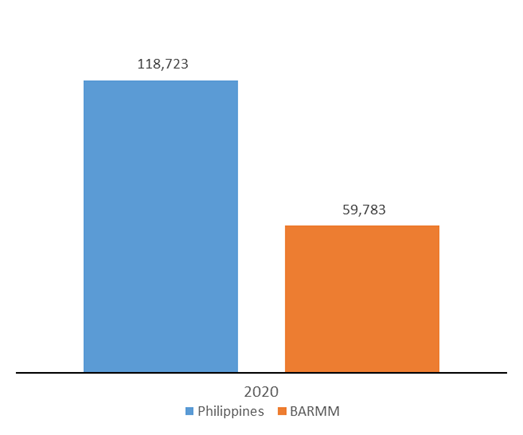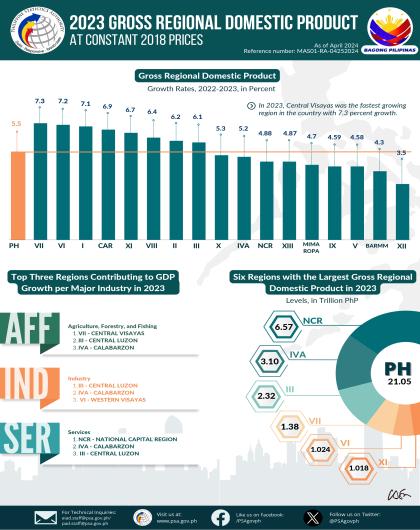(Click the link to view region highlights)
REGION:
NCR - National Capital Region
CAR - Cordillera Administrative Region
Region I - Ilocos Region
Region II - Cagayan Valley
Region III - Central Luzon
Region IV-A - CALABARZON
MIMAROPA REGION
Region V - Bicol Region
Region VI - Western Visayas
Region VII - Central Visayas
Region VIII - Eastern Visayas
Region IX - Zamboanga Peninsula
Region X - Northern Mindanao
Region XI - Davao Region
Region XII - SOCCSKSARGEN
Region XIII - Caraga
BARMM - Bangsamoro Autonomous Region in Muslim Mindanao
NCR - NATIONAL CAPITAL REGION [back to top]
NCR’s economy contracts by 10.1 percent in 2020
The economy of NCR declined by 10.1 percent in 2020 from 7.0 percent growth in the previous year. The industries that recorded the steepest declines were: Accommodation and food service activities with -51.9 percent; Other services with -48.7 percent; and Transportation and storage with -34.2 percent.
National Capital Region, Growth Rates by Industry: 2019 -2020
At Constant 2018 Prices, in percent
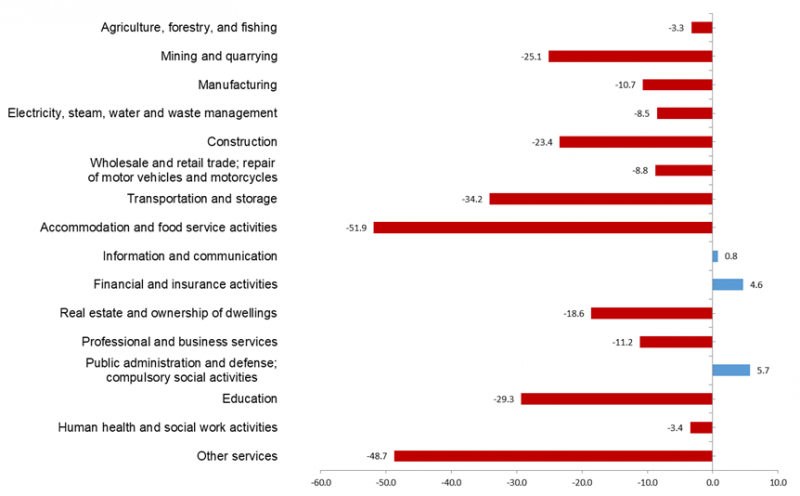
Services accounted for 81.0 percent in the region’s total GRDP in 2020, followed by Industry with 19.0 percent share.
Accounting for 31.9 percent of the total GDP, the highest among the regions, NCR contributed 3.2 percentage points to the total 9.6 percent contraction in the country’s economy in 2020.
NCR’s Government final consumption expenditure grows faster
NCR’s government spending or Government final consumption expenditure grew by 11.6 percent, faster than the 9.8 percent growth in the previous year. However, Household final consumption expenditure contracted by 8.5 percent from 6.5 percent growth in 2019. Gross fixed capital formation further declined by 32.4 percent from 0.7 percent in 2019. Total Exports of goods and services to Rest of the World (ROW) and total Imports of goods and services from ROW both declined by 16.7 percent and 19.1 percent, respectively.
National Capital Region, Growth Rates by Expenditure Type: 2019 -2020
At Constant 2018 Prices, in percent
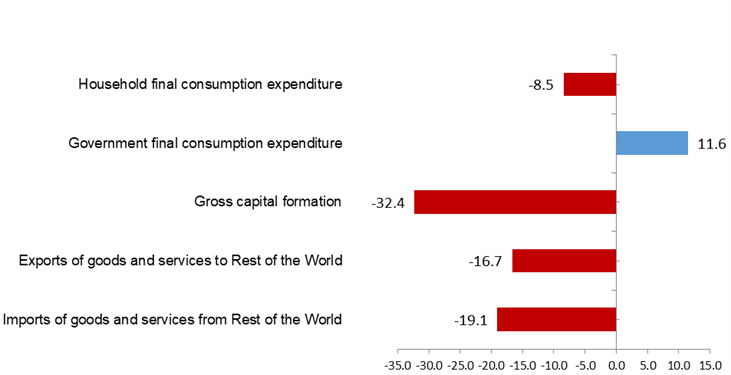
The per capita HFCE in the region was recorded at Php 216,824 in 2020, higher than the national level per capita HFCE of Php 118,723.
Per Capita Household Final Consumption Expenditure,
Philippines and National Capital Region, 2020
At Constant 2018 Prices, in Pesos
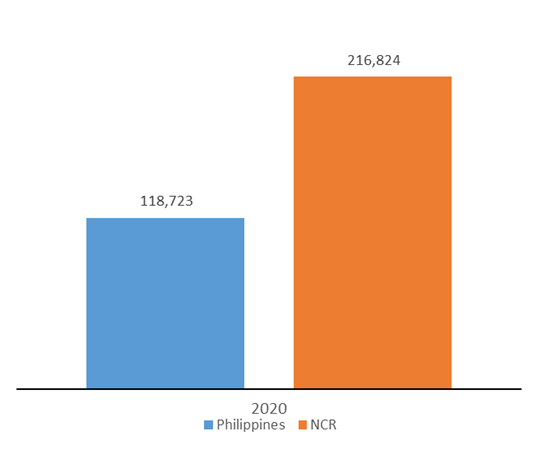
CAR - CORDILLERA ADMINISTRATIVE REGION [back to top]
Cordillera’s economy contracts by 9.9 percent in 2020
The economy of Cordillera contracted by 9.9 percent in 2020 from the 4.4 percent growth during the previous year. The fastest contractions were Other services, which include, but are not limited to, arts, entertainment and recreation, barbershops, salons and funeral parlors, with -51.4 percent; Accommodation and food service activities with -49.0 percent; Transportation and storage with -26.6 percent; and Manufacturing with -16.3 percent. The biggest contributors to the decline of CAR economy were Accommodation and food service activities and Manufacturing with 3.0 and 2.2 percentage points, respectively.
Cordillera Administrative Region, Growth Rates by Industry: 2019 -2020
At Constant 2018 Prices, in percent
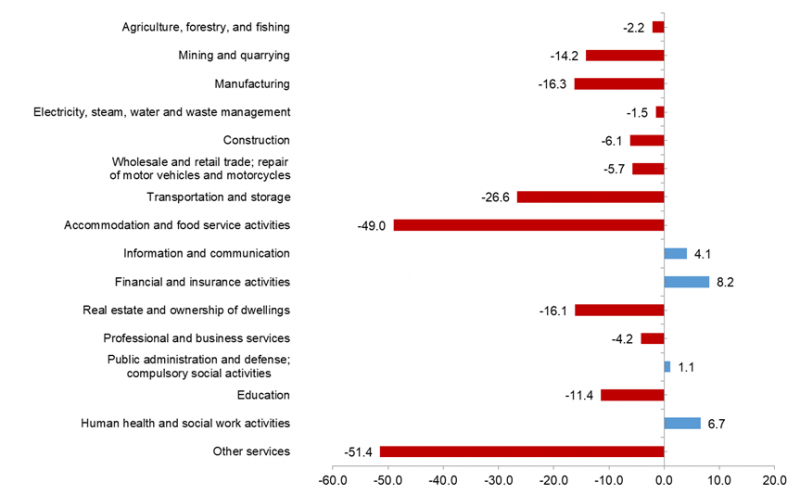
Services accounted for more than half of the region’s total economic output with 66.3 percent share followed by Industry with 23.6 percent share and Agriculture, Forestry, and Fishing with 10.1 percent share.
Of the 9.6 percent economic contraction of the country in 2020, Cordillera remained to be one of the least contributors with 0.2 percentage points. CAR economic output accounted for only 1.7 percent of the total GDP.
Cordillera’s exports of goods and services declines in 2020
Exports of goods and services to the Rest of the World was the major driver of the 9.9 percent decline of the CAR economy in 2020. Among all the expenditure items, only Government final consumption expenditure (GFCE) registered a growth of 7.2 percent. On the other hand, the 42.6 and 29.0 percent contractions observed from Imports and exports of goods and services from and to the Rest of the World greatly hampered the expansion of expenditures in the region.
Cordillera Administrative Region, Growth Rates by Expenditure Type: 2019 -2020
At Constant 2018 Prices, in percent
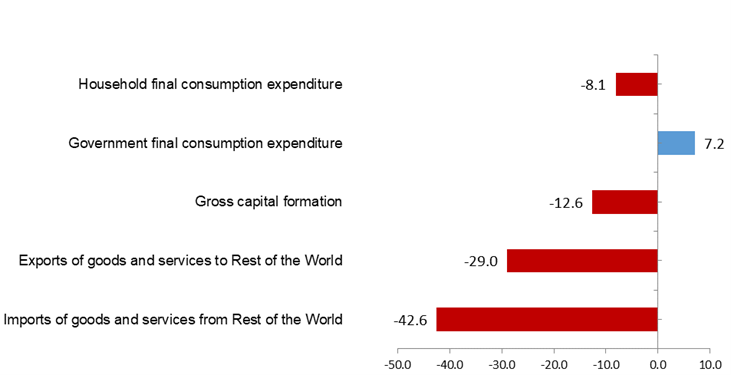
The per capita Household Final Consumption Expenditure (HFCE) of CAR was estimated at Php 118,236 in 2020. This means that, on the average, an individual member of a household spent Php 118,236 on final consumption of goods and services that includes purchase of consumer goods and services, barter transactions, goods and services in kind, and goods and services produced and consumed by the same individual. This decreased from the previous year’s per capita HFCE of Php 129,731. The per capita HFCE of CAR in 2020 was slightly lower than the national per capita HFCE of Php 118,723.
Per Capita Household Final Consumption Expenditure,
Philippines and CAR, 2020
At Constant 2018 Prices, in Pesos
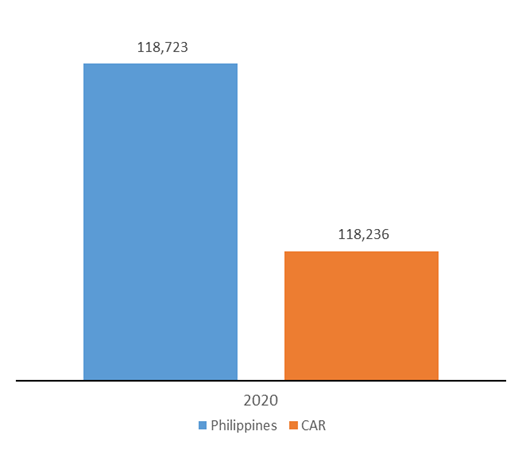
REGION I - ILOCOS REGION [back to top]
Ilocos Region’s economy declines by 7.7 percent
The economy of Ilocos Region declined by 7.7 percent in 2020 accounting to Php 581.9 billion, from the Php 630.4 billion of the previous year. The top three industries with highest declines were noted in Accommodation and food services activities at -46.6 percent; Other services, which include arts, entertainment and recreational services, at -41.5 percent; and Transportation and storage at -32.4 percent. Meanwhile, industries with the higher growth rates were: Financial and insurance activities at 7.7 percent; Information and communication at 6.5 percent; and Human health and social work activities at 5.7 percent.
Ilocos Region, Growth Rates by Industry: 2019 -2020
At Constant 2018 Prices, in percent
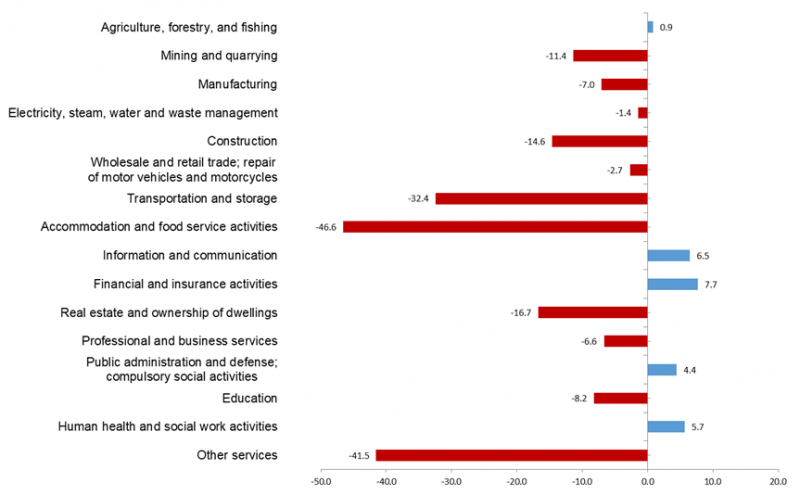
Among the major industries, Services contributed 5.0 percentage points to the total decline in the region’s economy, followed by Industry with 2.8 percentage points. Meanwhile, Agriculture, forestry, and fishing (AFF) registered a growth of 0.9 percent, accounting to 0.2 percentage point to the total growth in the economy. This is attributed to the increase in the value of production in the crops and fisheries subsectors in the region in 2020.
Of the 9.6 percent decline in the economy of the country, Ilocos Region contributed 0.3 percentage point, accounting for 3.3 percent share of the total Gross Domestic Product.
Ilocos Region’s household final consumption expenditure declines
Household final consumption expenditure (HFCE) in Ilocos Region declined by
8.0 percent from Php 622.2 billion in 2019 to Php 572.3 billion in 2020. Exports of goods and services to rest of the world also contracted accounting to 50.0 percent. This was followed by Imports of goods and services from the rest of the world with 36.8 percent and Gross capital formation with 22.2 percent. Meanwhile, government spending or Government final consumption expenditure in the region grew by 7.6 percent in 2020.
Ilocos Region, Growth Rates by Expenditure Type: 2019 -2020
At Constant 2018 Prices, in percent
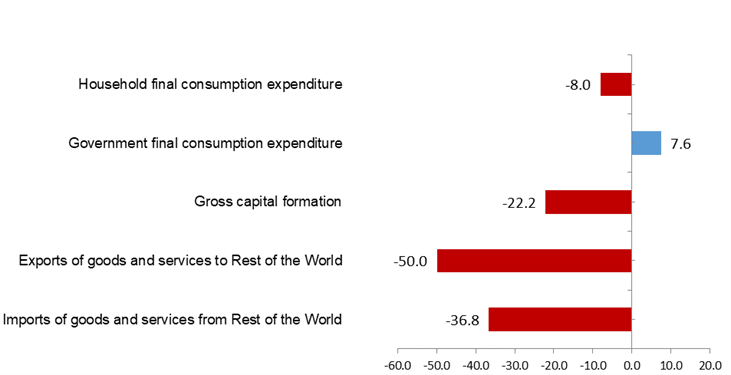
The per capita HFCE of Ilocos Region in 2020 was estimated at Php 108,577, lower than the national level at Php 118,723.
Per Capita Household Final Consumption Expenditure,
Philippines and Ilocos Region, 2020
At Constant 2018 Prices, in Pesos
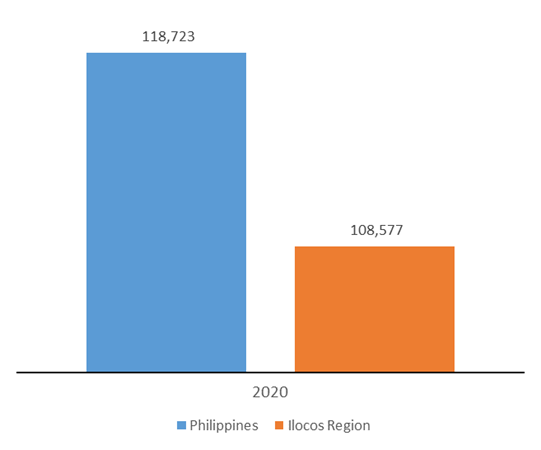
REGION II - CAGAYAN VALLEY [back to top]
Cagayan Valley’s economy declines by 9.9 percent
The economy of the Cagayan Valley Region declined by 9.9 percent in 2020. This was lower compared with the 6.9 percent growth recorded in the previous year. The economic contraction was mainly caused by the declines in Construction with 24.5 percent, Transportation and storage with 44.4 percent, and Mining and quarrying with 50.9 percent.
Despite the decline of the region’s economy, some industries still managed to grow in 2020. These industries are Financial and insurance activities which grew by 6.7 percent; Information and communication at 5.0 percent; Human health and social work activities at 7.4 percent; and Public administration and defense; compulsory social activities grew by 1.2 percent.
Cagayan Valley, Growth Rates by Industry: 2019 -2020
At Constant 2018 Prices, in percent
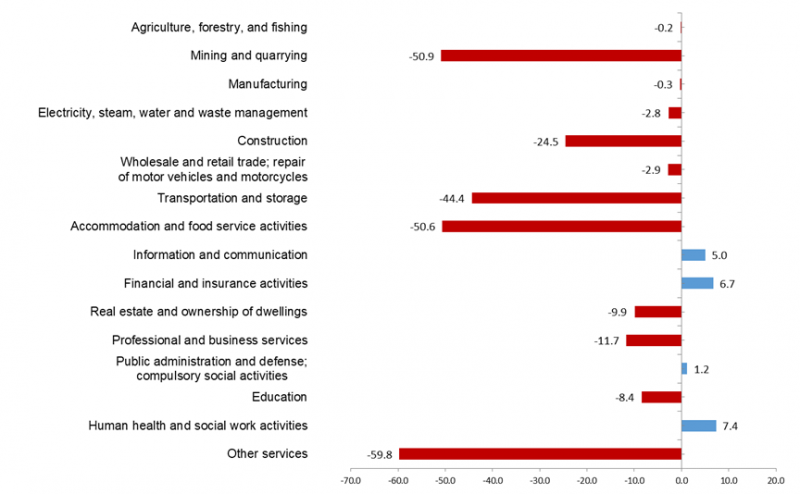
Among the major industries, Services, which accounted for the largest share of the regional economy at 43.0 percent, posted a decline of 11.6 percent. AFF, which accounted for 31.1 percent share, exhibited the least contraction at 0.2 percent. Industry, which accounted about 25.9 percent share, decreased by 16.9 percent.
Of the 9.6 percent economic contraction in the country, Cagayan Valley Region contributed -0.2 percentage point while accounting for 2.1 percent of the total GDP.
Cagayan Valley Region’s household spending decreases in 2020
Cagayan Valley’s household spending or Household final consumption expenditure (HFCE) registered a contraction of 8.4 percent. Exports of goods and services to Rest of the World posted the largest drop with 50.8 percent in 2020, followed by Gross capital formation which declined by 31.7 percent, and Imports of goods and services from ROW which dropped by 30.7 percent.
On the other hand, Cagayan Valley’s Government final consumption expenditure accelerated to 8.8 percent in 2020, which was faster compared with the 7.1 percent recorded in 2019.
Cagayan Valley, Growth Rates by Expenditure Type: 2019 -2020
At Constant 2018 Prices, in percent
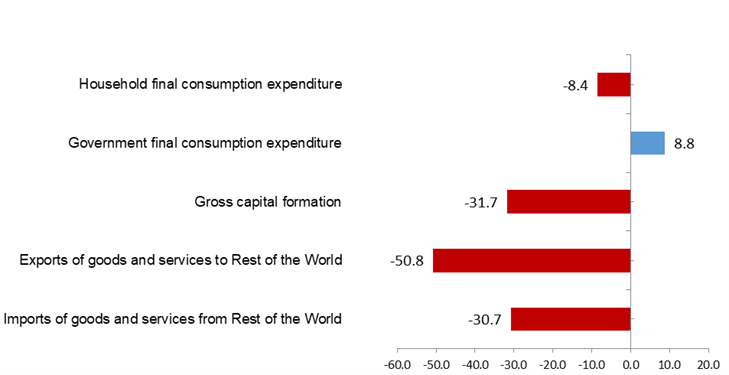
Real per capita HFCE declined by 9.4 percent in 2020. The real per capita HFCE in the region was recorded at Php 84,082, which was lower than the national level amounting to Php 118,723.
Per Capita Household Final Consumption Expenditure,
Philippines and Cagayan Valley, 2020
At Constant 2018 Prices, in Pesos
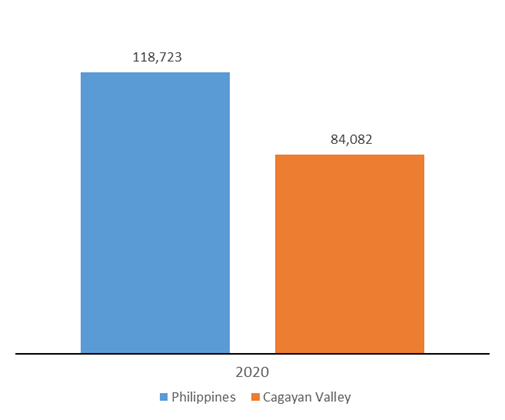
REGION III - CENTRAL LUZON [back to top]
Central Luzon’s economy drops by 13.9 percent
The economy of Central Luzon contracted by 13.9 percent in 2020 compared with the 5.9 percent growth in the previous year. The main drivers for the decline are Accommodation and food service activities with 45.2 percent; Mining and quarrying, and Other services both with 32.5 percent; and Construction with 29.4 percent. On the other hand, positive growth were noted in Information and communication at 10.8 percent; Financial and insurance activities at 6.8 percent; and Public Administration and defense; compulsory social activities at 1.5 percent.
Central Luzon, Growth Rates by Industry: 2019 -2020
At Constant 2018 Prices, in percent
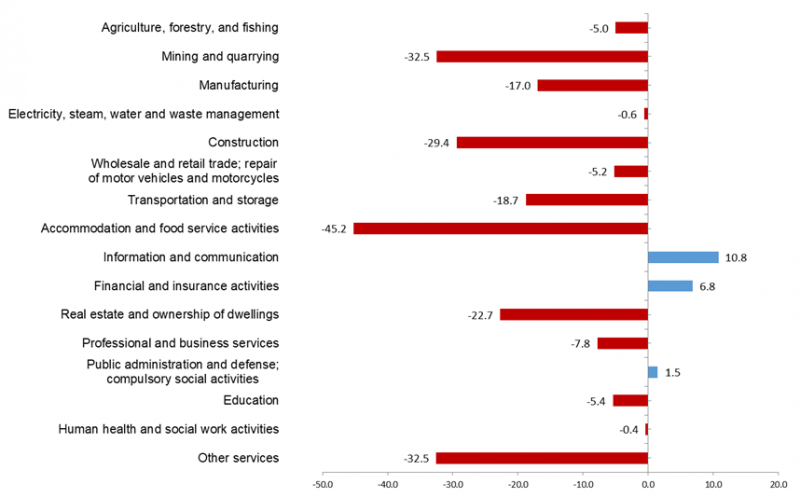
Services accounted for 46.6 percent of the region’s total economy in 2020, followed by Industry with 39.9 percent and Agriculture, forestry, and fishing with 13.5 percent.
Services declined by 10.6 percent in 2020 compared with the 7.0 percent growth in 2019. This was mainly attributed to the contraction in Accommodation and food service activities and Other services.
Of the 9.6 percent economic drop in the country, Central Luzon was the second largest contributor to the decline with 1.6 percentage points, accounting for 10.7 percent of the total GDP.
Central Luzon’s gross capital formation contracts by 43.9 percent
Central Luzon's gross capital formation posted a contraction of 43.9 percent in 2020. Household final consumption expenditure also declined by 7.1 percent, compared with the 5.5 percent growth during the previous year. Gross fixed capital formation declined significantly by 30.6 percent in 2020, from a 7.6 percent growth in 2019. Total exports of goods and services to rest of the world (ROW) and Total imports of goods and services from ROW both registered declines of 15.3 percent and 22.6 percent, respectively. However, government spending in the region grew by 9.1 percent during the period.
Central Luzon, Growth Rates by Expenditure Type: 2019 -2020
At Constant 2018 Prices, in percent
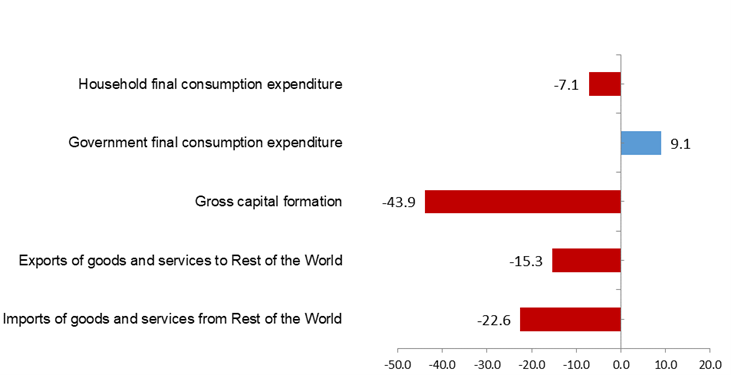
Real per capita HFCE considerably dropped by 8.7 percent in 2020. The real per capita HFCE in the region was recorded at Php 142,950 in 2020, higher than the national level which amounted to Php 118,723.
Per Capita Household Final Consumption Expenditure,
Philippines and Central Luzon, 2020
At Constant 2018 Prices, in Pesos
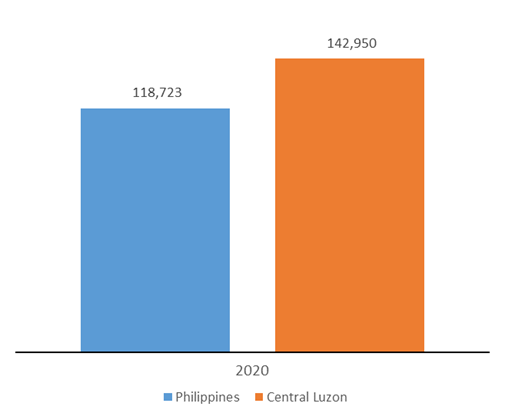
REGION IVA - CALABARZON [back to top]
CALABARZON’s economy contracts in 2020
The economy of CALABARZON contracted by 10.5 percent in 2020 from a 4.6 percent growth in the previous year. The top contributors to the decline were Manufacturing, which dropped by 11.6 percent; Construction at -36.0 percent; and Real estate and ownership of dwellings at -17.8 percent. Industries that registered growth are Information and communication at 7.7 percent, Financial and insurance activities at 7.5 percent, Public administration and defense, compulsory social activities at 3.1 percent; and Electricity, steam, water and waste management at 1.7 percent.
CALABARZON, Growth Rates by Industry: 2019 -2020
At Constant 2018 Prices, in percent
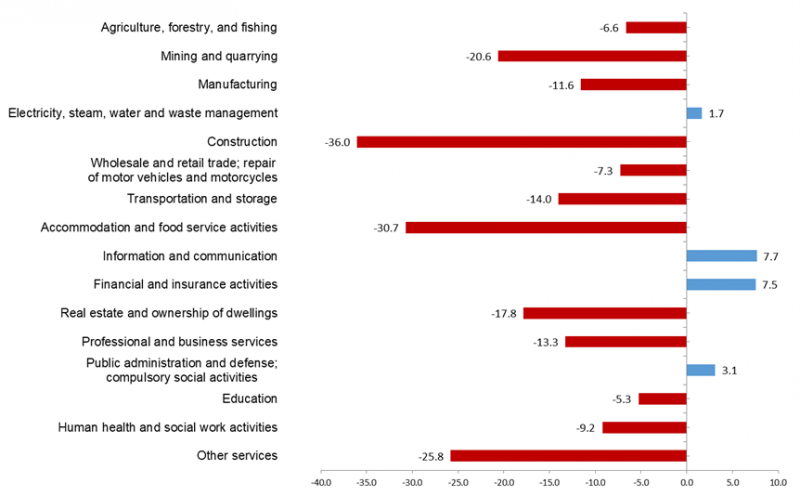
Among the three major economic industries, Industry had the largest share of 49.4 percent of the region’s economy; followed by Services with 44.8 percent share. Agriculture, forestry and fishing had the least share of 5.7 percent.
CALABARZON is the only predominantly industrial region. Overall, Industry dropped by 12.5 percent in 2020 compared with the 3.6 percent growth recorded in 2019. This was mainly attributed to the decline observed in its two industries, that is Manufacturing and Construction.
Of the -9.6 percent economic performance of the country, CALABARZON ranked third that contributed the most to its decline with -1.5 percentage points while accounting for 14.5 percent of the total GDP.
CALABARZON posts the largest decline in Gross capital formation in 2020
CALABARZON’s spending on Gross capital formation posted the largest drop by 51.0 percent in 2020. Total Imports of goods and services from rest of the world (ROW) and total Exports of goods and services to ROW both declined by 24.1 percent and 10.3 percent, respectively. Likewise, Household final consumption expenditure (HFCE) dropped by 8.0 percent from a 6.1 percent growth in 2019. On the other hand, government spending in the region accelerated to 10.1 percent in 2020 compared with the 9.0 percent growth during the previous period.
CALABARZON, Growth Rates by Expenditure Type: 2019 -2020
At Constant 2018 Prices, in percent
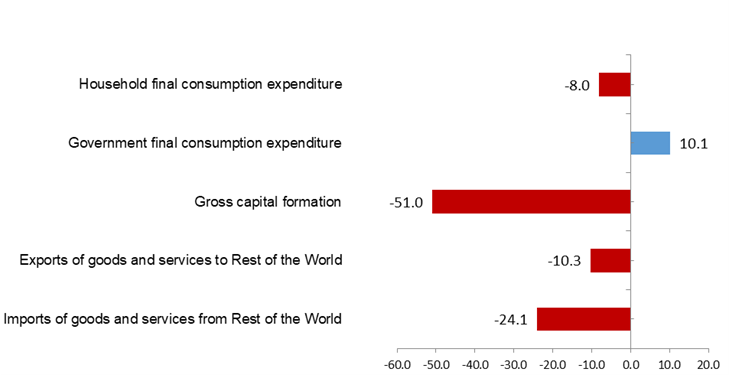
Real per capita HFCE declined by 9.8 percent in 2020. The real per capita HFCE in the region was recorded at Php 133,986, higher than the national level which was estimated at Php 118,723.
Per Capita Household Final Consumption Expenditure,
Philippines and CALABARZON, 2020
At Constant 2018 Prices, in Pesos
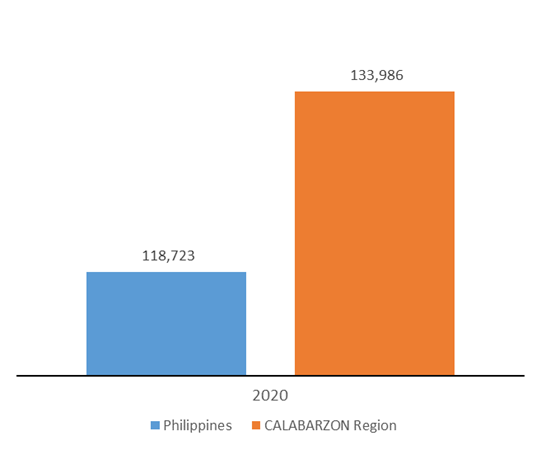
MIMAROPA REGION [back to top]
MIMAROPA’s economy declines by 7.6 percent in 2020
The economy of MIMAROPA declined by 7.6 percent in 2020 compared with the 4.3 percent growth in 2019. The main contributors to the decline were: Accommodation and food service activities with -45.5 percent; Transportation and storage with -29.4 percent; and Construction with -23.6 percent. On the other hand, the industries that contributed to the growth of the economy were: Information and communication with 6.9 percent; Financial and insurance activities with 5.6 percent; Public administration and defense; compulsory social activities with 4.3 percent; and Electricity, steam, water and waste management with 2.9 percent.
MIMAROPA Region, Growth Rates by Industry: 2019 -2020
At Constant 2018 Prices, in percent
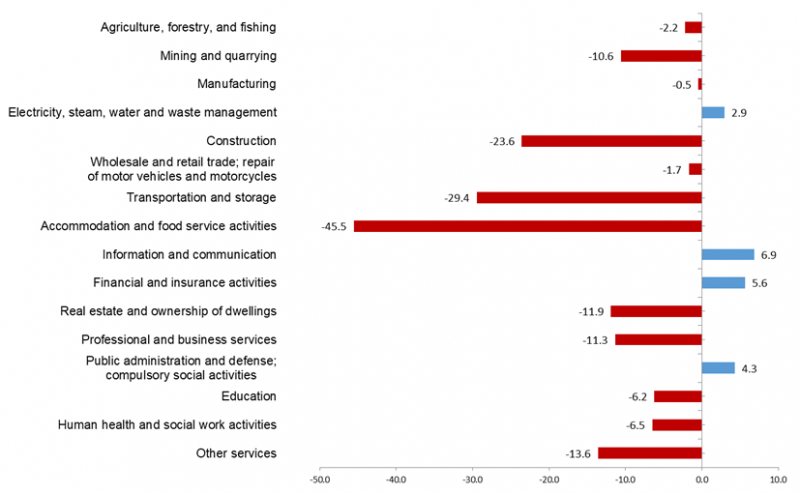
Among the major economic sectors, Services accounted for 45.6 percent of the region’s economy, followed by Industry with 35.2 percent share and Agriculture, forestry and fishing with 19.2 percent share.
Services contracted by 9.2 percent in 2020 from 5.8 percent growth in 2019. This was mainly attributed to the decline in eight of its eleven industries under it, which include Accommodation and food service activities; Transportation and storage; and Other Services. Agriculture, forestry and fishing decreased by 2.2 percent in 2020 from 4.7 percent growth in 2019. Industry declined by 8.2 percent in 2020 compared with the 2.2 percent growth in the previous year due to continued decline in Construction, Mining and Quarrying, and Manufacturing.
Among the 17 regions in the country, ten regions registered lower decline than the national economy including the MIMAROPA region. Of the 9.6 percent contraction in the economic growth of the country, MIMAROPA region accounted for 0.2 percentage point of the total GDP.
MIMAROPA region’s government spending accelerates in 2020
MIMAROPA region’s Government final consumption expenditure accelerated by 9.6 percent in 2020 compared to 3.4 percent growth in 2019. Other expenditure items contracted in 2020. Exports of goods and services to rest of the world had the highest contraction of 46.1 percent from a decline of 3.1 percent in 2019. It was followed by Gross capital formation which decreased by 35.3 percent in 2020 from a 9.3 percent growth in 2019. Imports of goods and services from the rest of the world and household final consumption expenditure declined by 28.8 percent and 7.9 percent, respectively.
MIMAROPA Region, Growth Rates by Expenditure Type: 2019 -2020
At Constant 2018 Prices, in percent
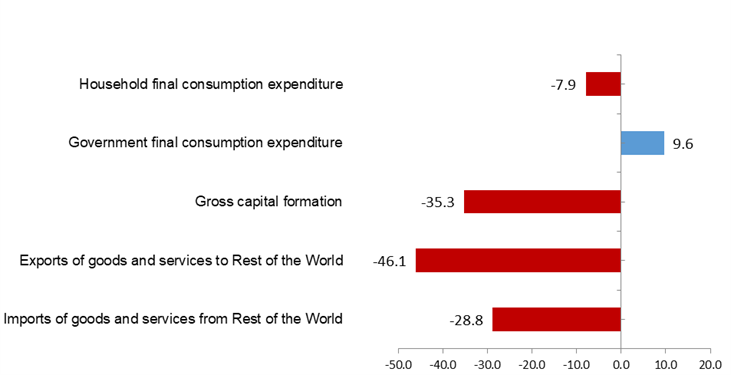
Gross capital formation posted the highest contribution to the decline of the region contributing 7.9 percentage points. On the other hand, Total Net Exports had the largest positive contribution at the expenditure side with 5.8 percentage points.
Per capita household final consumption expenditure decelerated by 9.0 percent in 2020. The per capita HFCE, at constant 2018 prices, in the region was recorded at Php 95,469 in 2020, 19.6 percent lower than the national level which amounted to Php 118,723.
Per Capita Household Final Consumption Expenditure,
Philippines and MIMAROPA Region, 2020
At Constant 2018 Prices, in Pesos
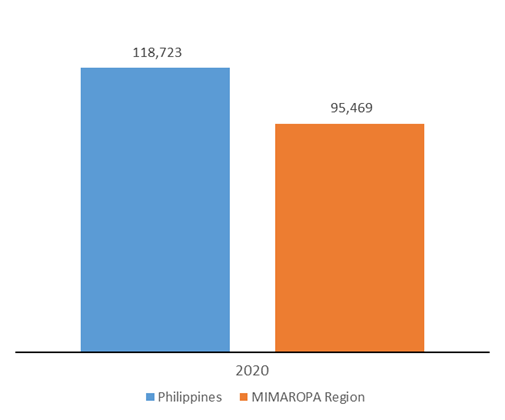
REGION V - BICOL REGION [back to top]
Bicol Region’s economy declines by 8.4 percent in 2020
The economy of Bicol Region declined by 8.4 percent in 2020 compared with 8.2 percent growth in the previous year. The main drivers of the decline were: Construction which declined by 20.2 percent; Transportation and storage which declined by 37.8 percent, and Other services which declined by 34.7 percent.
Bicol Region, Growth Rates by Industry: 2019 -2020
At Constant 2018 Prices, in percent
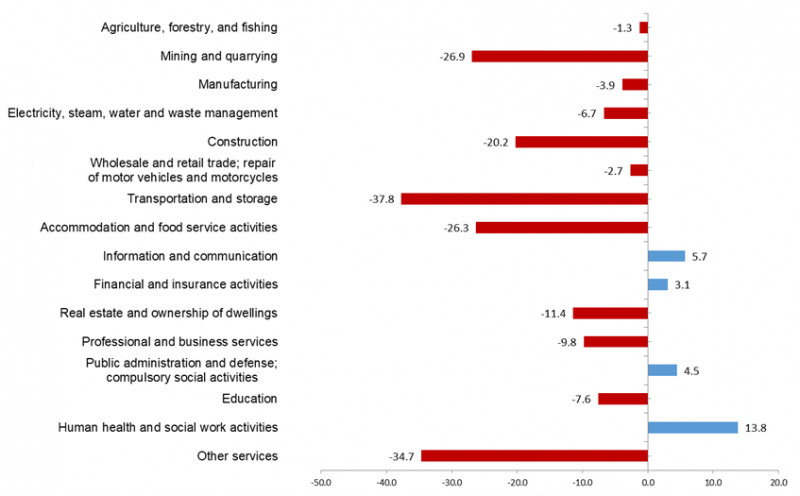
Most of the industries posted negative rates in 2020, except for the following industries that registered growth: Information and communication which grew at 5.7 percent, Financial and insurance activities at 3.1 percent, Public administration and defense; compulsory social activities at 4.5 percent, and Human health and social work at 13.8 percent. Among the major economic industries, Agriculture, forestry, and fishing contracted by 1.3 percent, Industry declined by 13.6 percent, and Services reduced by 6.9 percent.
Services remained to account for the largest share in the region’s economy in 2020 at 47.9 percent, followed by Industry with 34.2 percent, and Agriculture, forestry and fishing with 17.9 percent share.
Of the 9.6 percent economic decline of the country in 2020, Bicol Region contributed -0.2 percentage points. Bicol economic output accounted for 3.0 percent of the Philippine economy.
Bicol Region’s posts 9.0 percent increase in government spending in 2020
Bicol Region posted a 9.5 percent increase in Government Final Consumption Expenditure (GFCE) in 2020 from 12.9 percent growth in 2019.
The economic performance of the region, however, was pulled down by the declines posted by other major expenditure items. Exports of goods and services to the Rest of the World registered the largest decline at -37.2 percent. Gross Capital Formation (GCF) declined by 29.2 percent, followed by Imports of goods and services from the Rest of the World at -18.9 percent. Household Final Consumption Expenditure (HFCE) also dropped by 8.5 percent.
Bicol Region, Growth Rates by Expenditure Type: 2019 -2020
At Constant 2018 Prices, in percent
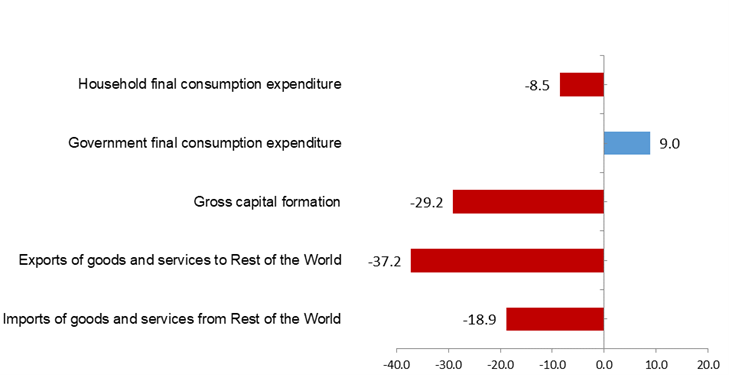
Bicol Region’s per capita HFCE contracted by 9.4 percent amounting to Php 88,818 in 2020, lower than the national level at Php 118,723.
Per Capita Household Final Consumption Expenditure,
Philippines and Bicol Region, 2020
At Constant 2018 Prices, in Pesos
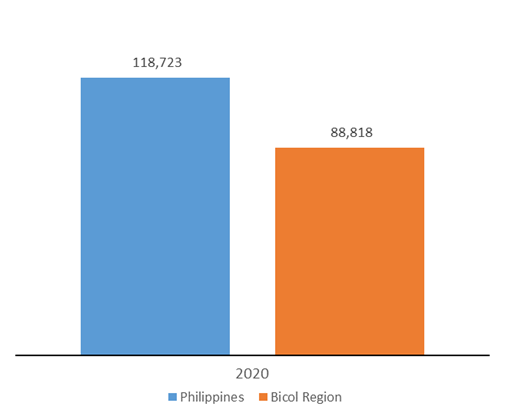
REGION VI - WESTERN VISAYAS [back to top]
Western Visayas’ economy contracts in 2020 by 9.7 percent
The economy of Western Visayas contracted by 9.7 percent in 2020 from the 6.3 percent growth in 2019. The main drivers for the decline were: Transportation and storage with -39.1 percent; Other services with -55.6 percent; Accommodation and food service activities with -59.4 percent; Construction with -18.0 percent; and Real estate and ownership of dwellings with -13.3 percent.
On the other end, Agriculture, forestry, and fishing (AFF) of the region grew by 6.2 percent, the fastest growth among all regions in the country. Other three industries that posted positive growth in 2020 were: Public administration and defense; compulsory social activities with 3.9 percent; Information and communication with 3.7 percent; and Financial and insurance activities with 3.3 percent.
Western Visayas, Growth Rates by Industry: 2019 -2020
At Constant 2018 Prices, in percent
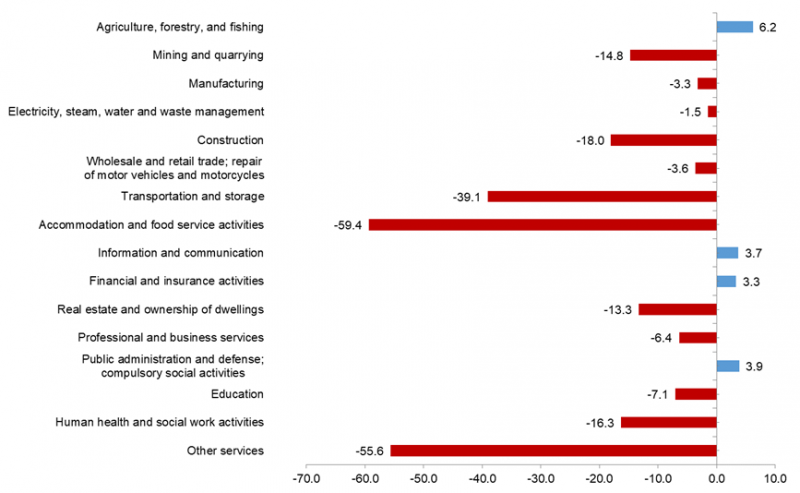
Among the major industries, Services accounted 58.9 percent of the region’s total economy in 2020. Industry shared 21.3 percent while AFF shared 19.9 percent.
Of the 9.6 percent decline in the GDP of the country, Western Visayas was the fifth negative contributor with -0.5 percentage point, and accounting for 4.7 percent share to the national GDP.
Western Visayas’ household spending declines by 8.5 percent in 2020
Western Visayas’ household spending or Household Final Consumption Expenditure (HFCE) contracted by 8.5 percent in 2020. This was a reversal from 5.4 percent growth in 2019. The contraction was also observed in the following expenditure item: Gross capital formation with 28.0 percent; Exports of goods and services to rest of world (ROW) with 38.8 percent; and Imports of goods and services from ROW with 17.5 percent.
On the contrary, government spending or Government final consumption expenditure grew faster by 8.1 percent in 2020 from 7.5 percent in 2019.
Western Visayas, Growth Rates by Expenditure Type: 2019 -2020
At Constant 2018 Prices, in percent
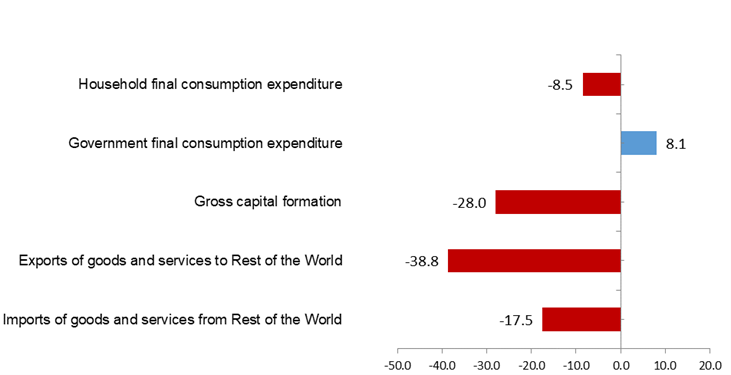
Household spending of each individual in the region decreased by 9.3 percent in 2020. The real per capita HFCE of the region was recorded at Php 95,370, lower than the Php 118,723 national per capita level.
Per Capita Household Final Consumption Expenditure,
Philippines and Western Visayas, 2020
At Constant 2018 Prices, in Pesos
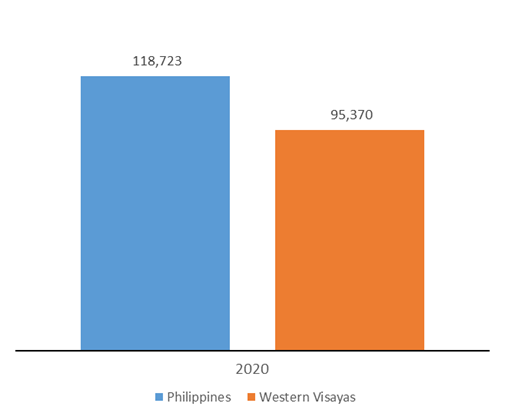
REGION VII - CENTRAL VISAYAS [back to top]
Central Visayas’ economy declines by 9.9 percent in 2020
The economy of Central Visayas declined by 9.9 percent in 2020 compared with the 6.2 percent growth recorded in 2019. The main contributors to the decline were: Construction at -36.4 percent; Manufacturing at -12.9 percent, and Transportation and storage at 37.4 percent.
Central Visayas, Growth Rates by Industry: 2019 -2020
At Constant 2018 Prices, in percent
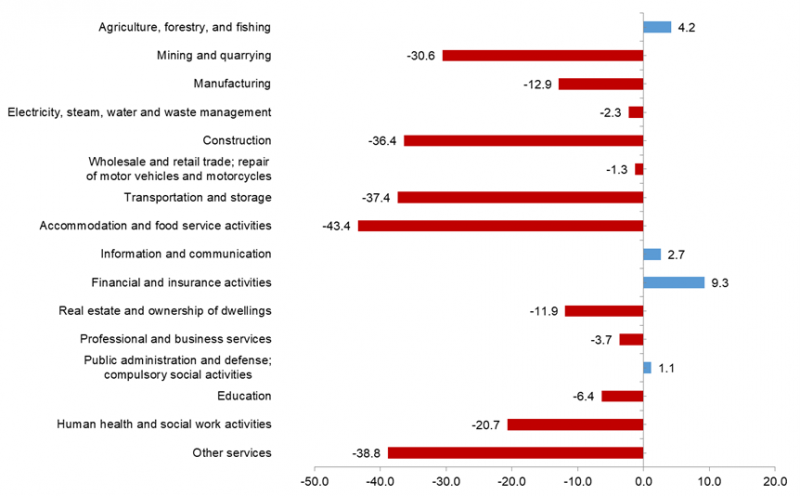
Among the three major industries, Services accounted the highest share of 68.0 percent in the region’s total GRDP in 2020, followed by Industry with 24.6 percent, and Agriculture, forestry and fishing (AFF) with 7.4 percent.
In 2020, AFF grew by 4.2 percent from the 0.8 percent growth registered in 2019. Meanwhile, Services declined by 7.9 percent compared with the 7.3 percent growth in 2019. This negative rate was attributed to the declines in Transportation and storage, and Accommodation and food service activities. Further, the decline in Industry by 18.3 percent was mainly attributed due to Construction.
Of the 9.6 percent decline in the country’s economic performance, Central Visayas contributed -0.6 percentage point and accounted for 6.4 percent of the total GDP in 2020.
Central Visayas’ Government final consumption expenditure increases by 10.6 percent in 2020
In 2020, all major expenditure items posted declines except Government final consumption expenditure (GFCE). Government spending or GFCE of Central Visayas increased by 10.6 percent from the 8.2 percent growth recorded in 2019. On the other hand, gross capital formation accounted for the highest decline during the period with -38.3 percent compared with 16.1 percent growth in 2019. Household final consumption expenditure (HFCE) declined by 7.7 percent. Total Exports of goods and services to Rest of the World (ROW) and total Imports of goods and services from ROW both registered declines of 20.1 percent and 21.8 percent, respectively.
Central Visayas, Growth Rates by Expenditure Type: 2019 -2020
At Constant 2018 Prices, in percent
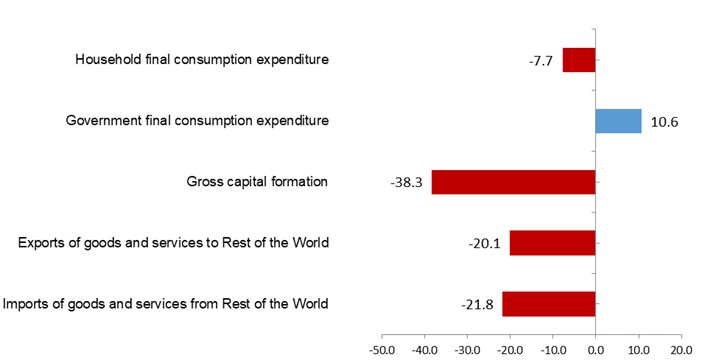
Real per capita HFCE declined by 8.9 percent in 2020 compared with 3.7 percent in 2019. The real per capita HFCE in the region was recorded at Php 100,409 lower than the national level which amounted to Php 118,723.
Per Capita Household Final Consumption Expenditure,
Philippines and Central Visayas, 2020
At Constant 2018 Prices, in Pesos
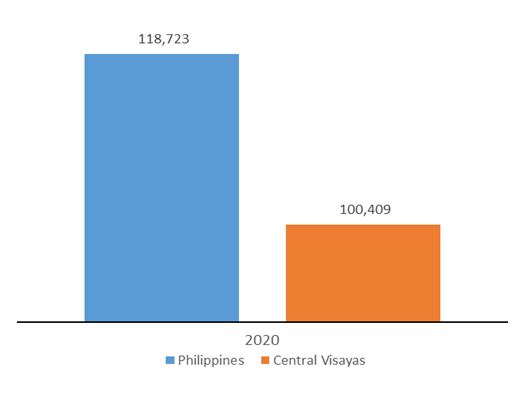
REGION VIII - EASTERN VISAYAS [back to top]
Eastern Visayas’ economy contracts by 7.6 percent in 2020
The economy of Eastern Visayas contracted by 7.6 percent in 2020 from its 5.6 percent growth recorded in 2019. The total value of goods and services in the region or the Gross Regional Domestic Product (GRDP) declined to Php 433.4 billion in 2020 from Php 469.3 billion in 2019. The economic contraction was mainly driven by the decline in Construction with 34.2 percent, Transportation and storage with 40.2 percent, Accommodation and food services activities with 70.4 percent, and Real estate and ownership of dwellings with 11.6 percent.
The upbeat performance of manufacturing slightly mitigated the contraction of the regional economy after posting 20.8 percent growth.
Eastern Visayas, Growth Rates by Industry: 2019 -2020
At Constant 2018 Prices, in percent
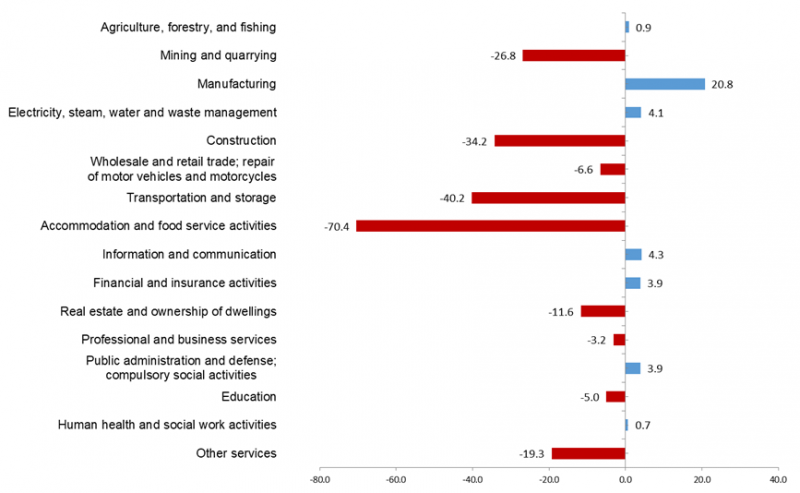
Services and Industry contributed -4.4 percentage points and -3.4 percentage points, respectively to the region’s 7.6 percent contraction in 2020. Meanwhile, Agriculture, Forestry and Fishing (AFF) contributed 0.1 percentage point.
Services shared 45.6 percent of the region’s economy, followed closely by Industry at 39.6 percent. AFF had the smallest share at 14.8 percent.
Eastern Visayas contributed -0.2 percentage point to the country’s 9.6 percent decline in 2020. The economic output of the region accounted for 2.5 percent of the Philippine economy.
Eastern Visayas posts 9.5 percent increase in government spending in 2020
Eastern Visayas posted a 9.5 percent expansion in Government final consumption expenditure (GFCE) in 2020 from 7.0 percent growth in 2019.
The economic performance of the region, however, was pulled down by the declines posted by other major expenditure items. Gross capital formation (GCF) suffered the biggest drop in 2020 at 40.4 percent. Exports of goods and services to Rest of the World (ROW) declined by 13.6 percent while Imports of goods and services from ROW also dropped by 17.9 percent. Likewise, the region’s Household final consumption expenditure (HFCE) contracted by 7.9 percent.
Eastern Visayas, Growth Rates by Expenditure Type: 2019 -2020
At Constant 2018 Prices, in percent
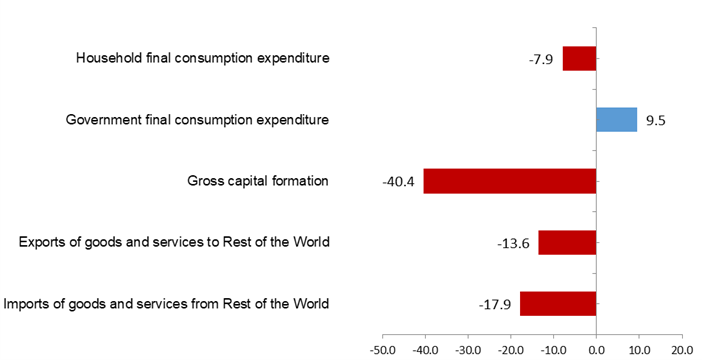
The real per capita HFCE of the region was estimated at Php 79,116 in 2020. This was lower by 9.1 percent from the previous year’s per capita household spending amounting to Php 87,033. The region’s real per capita HFCE was also lower than the national level estimated at Php 118,723.
Per Capita Household Final Consumption Expenditure,
Philippines and Eastern Visayas, 2020
At Constant 2018 Prices, in Pesos
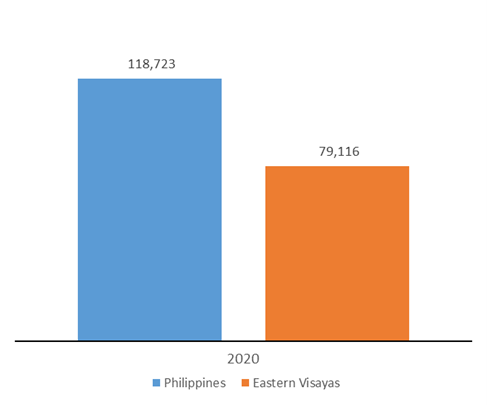
REGION IX - ZAMBOANGA PENINSULA [back to top]
Zamboanga Peninsula’s economy declines by 5.2 percent in 2020
The Zamboanga Peninsula’s economy posted a contraction of 5.2 percent in 2020 from a 4.6 percent growth in 2019. The reversal in the region’s economy in 2020 was caused by the decline in most of the industries. Other Services had the highest decline with -66.2 percent, followed by Accommodation and food service activities with -47.2 percent, and Transportation and Storage with -39.5 percent.
Zamboanga Peninsula, Growth Rates by Industry: 2019 -2020
At Constant 2018 Prices, in percent

Services accounted for 51.5 percent share to the total regional economy, followed by industry with 29.2 percent share and Agriculture, forestry, and fishing with 19.3 percent share.
Services declined by 8.4 percent in 2020, which was a reversal as compared with the 8.5 percent growth in 2019. This was mainly attributed to the decline observed in majority of industries. On the other hand, Manufacturing, with 18.2 percent share to the regional economy, accelerated by 9.5 percent in 2020 from 0.3 percent in 2019.
Of the 9.6 percent economic decline of the country, Zamboanga Peninsula contributed -0.1 percentage point while accounting for 2.1 percent of the total GDP.
Zamboanga Peninsula’s government final consumption expenditure increases
The Zamboanga Peninsula’s Government final consumption expenditure (GFCE) accelerated by 12.5 percent in 2020, higher than the 6.1 percent growth in 2019. However, Household final consumption expenditure (HFCE) plunged to -7.7 percent in 2020, compared with the 7.3 percent growth during the previous period. Gross capital formation (GCF) declined further by 12.3 percent in 2020, from a contraction of 3.2 percent in 2019. Meanwhile, Exports of goods and services to Rest of the World (ROW) and Imports of goods and services from ROW both registered contractions of 46.2 percent and 26.0 percent, respectively.
Zamboanga Peninsula, Growth Rates by Expenditure Type: 2019 -2020
At Constant 2018 Prices, in percent
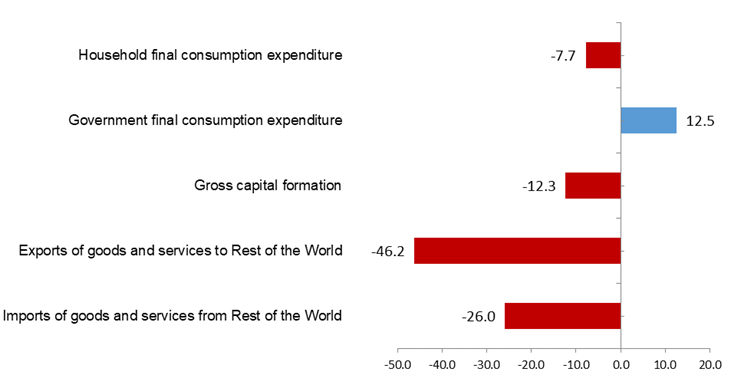
Real per capita HFCE dropped by 8.4 percent in 2020. It was recorded at Php 74,665 in 2020, which was lower than the national level amounting to Php 118,723.
Per Capita Household Final Consumption Expenditure,
Philippines and Zamboanga Peninsula, 2020
At Constant 2018 Prices, in Pesos
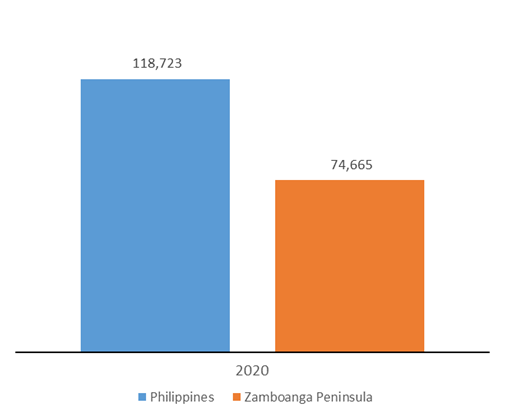
REGION X - NORTHERN MINDANAO [back to top]
Northern Mindanao’s economy loses Php 44.8-B in 2020
The economy of the region declined by 5.2 percent in 2020 which translated to an economic loss of Php 44.8 billion. The Gross Regional Domestic Product (GRDP) of the region reduced to Php 822.6 billion in 2020 from its recorded GRDP of Php 867.4 billion in the previous year. The main drivers of the economic contraction were: Construction recording a decline of 21.7 percent; Wholesale and retail trade, repair of motor vehicles and motorcycles with -5.7 percent; and Transportation and storage at -39.5 percent. On the other hand, the top industries that posted expansion were Manufacturing, Financial and insurance activities, and Information and communication, at 11.0 percent, 8.0 percent and 4.7 percent, respectively. Northern MIndanao was third among the 17 regions in terms of slowest contraction of the regional economy in 2020.
Northern Mindanao, Growth Rates by Industry: 2019 -2020
At Constant 2018 Prices, in percent
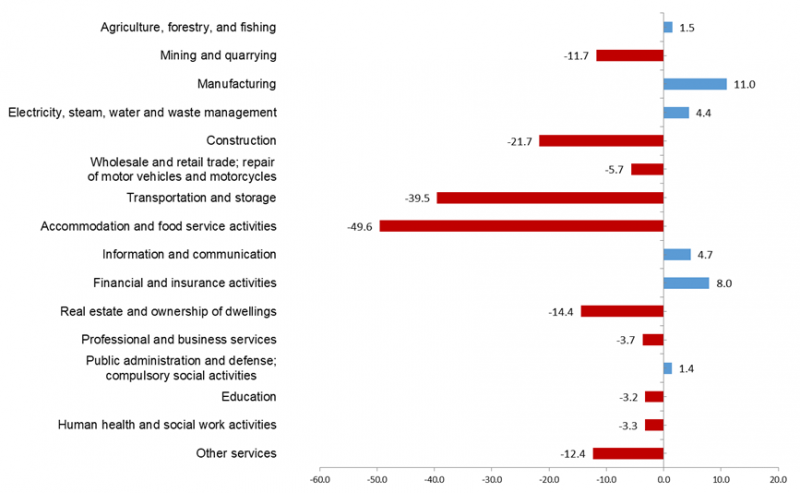
Services, which accounted for 53.1 percent to Northern Mindanao’s economy in 2020, dropped by 9.0 percent in 2020. While Industry contributed 25.2 percent share to the economy, and Agriculture, forestry, and fishing shared 21.7 percent. Eight out of 11 industries in Services recorded contraction in 2020. Industries which contributed most to the decline in Services were Wholesale and retail trade, repair of motor vehicles and motorcycles, Transportation and Storage, and Accommodation and food service activities.
Northern Mindanao’s economy remained to have the 7th biggest share to the Philippine economy at 4.7 percent. The region contributed -0.2 percentage point to the GDP decline of -9.6 percent in 2020. Moreover, Northern Mindanao was the 9th biggest contributor among the regions to the contraction of the Philippine economy.
Northern Mindanao still records the highest expansion of government spending
With the recorded decline in Northern Mindanao’s GRDP, all major expenditure items recorded decline in 2020 except Government final consumption expenditure (GFCE). Government spending or GFCE increased by 13.0 percent, slower than its recorded growth in the previous year at 18.6 percent. Northern Mindanao remained to have the fastest increase in government spending since 2019.
Northern Mindanao, Growth Rates by Expenditure Type: 2019 -2020
At Constant 2018 Prices, in percent
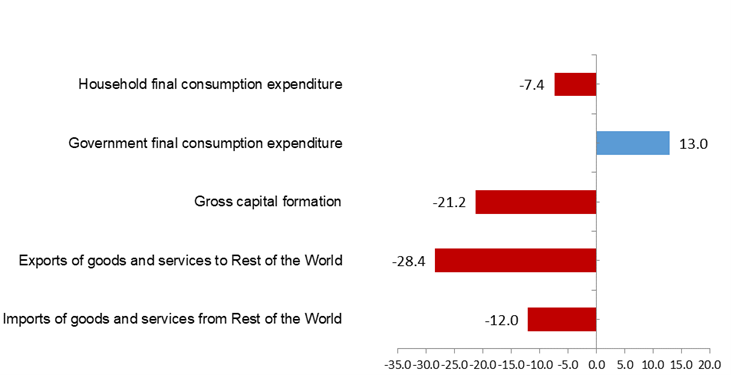
Real per capita HFCE decreased by 8.5 percent in 2020. The real per capita HFCE in the region was recorded at Php 89,612 in 2020, lower by 24.5 percent from the national level real per capita HFCE of Php 118,723.
Per Capita Household Final Consumption Expenditure,
Philippines and Northern Mindanao, 2020
At Constant 2018 Prices, in Pesos
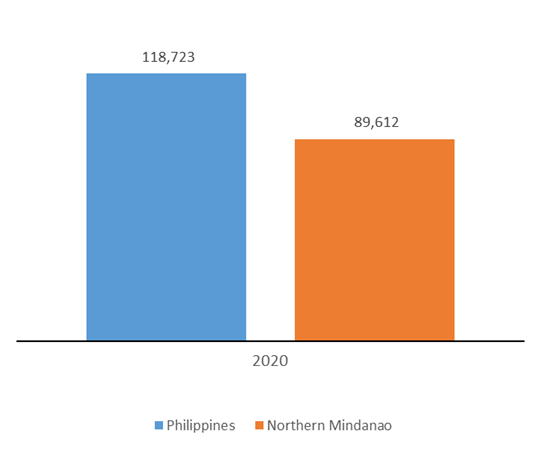
REGION XI - DAVAO REGION [back to top]
Davao Region’s economy contracts by 7.6 percent in 2020
The economy of Davao Region contracted by 7.6 percent in 2020, mainly due to the decline in Industry and Services. The top industries with the deepest dive are Other services with a contraction of 38.2 percent, Accommodation and food service activities with a decline of 34.7 percent, and Transportation and storage with a drop of 34.5 percent. Declines are also noted in Mining and quarrying, Manufacturing, Construction, Real estate and ownership of dwellings, Professional and business services, Education, and Human health and social work activities.
Davao Region, Growth Rates by Industry: 2019 -2020
At Constant 2018 Prices, in percent
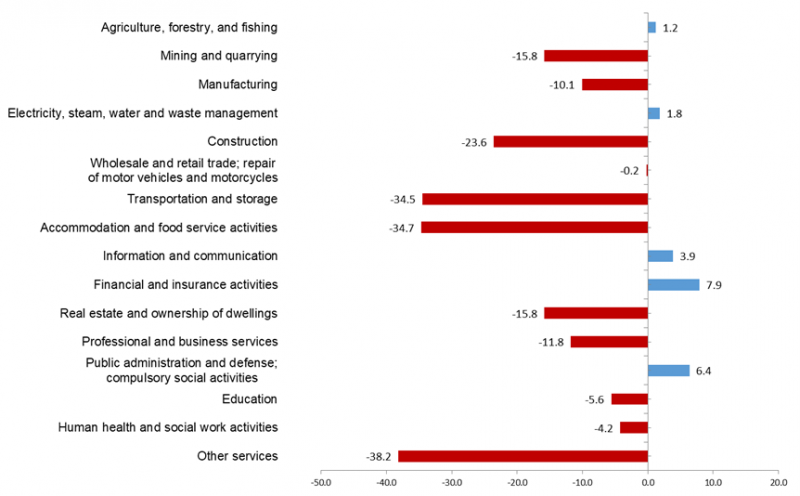
Services, which contributed 58.9 percent share to the regional economy, declined by 6.7 percent in 2020 as almost all its industries contracted in 2020. Industry, which accounted for 24.2 percent share, dropped by 14.9 percent. It was mainly attributed to the downturn in Mining and quarrying, Manufacturing, and Construction.
Industry and Services have the biggest contribution to the economic contraction of Davao region, pulling down the growth by a total of 7.8 percentage points while Agriculture, forestry, and fishing contributed 0.2 percentage point to the region’s economy.
Davao Region’s government spending increases in 2020
With the recorded decline in Davao Region’s economy, all major expenditure items recorded decline in 2020, except for Government final consumption expenditure (GFCE). Government spending or GFCE of the region accelerated by 11.9 percent. Household spending or HFCE declined by 7.5 percent, while Investments or Gross capital formation posted a downturn by 15.3 percent. Exports of goods and services to the Rest of the World (ROW) and imports of goods and services from ROW also dropped by 26.4 percent and 18.7 percent, respectively.
Davao Region, Growth Rates by Expenditure Type: 2019 -2020
At Constant 2018 Prices, in percent
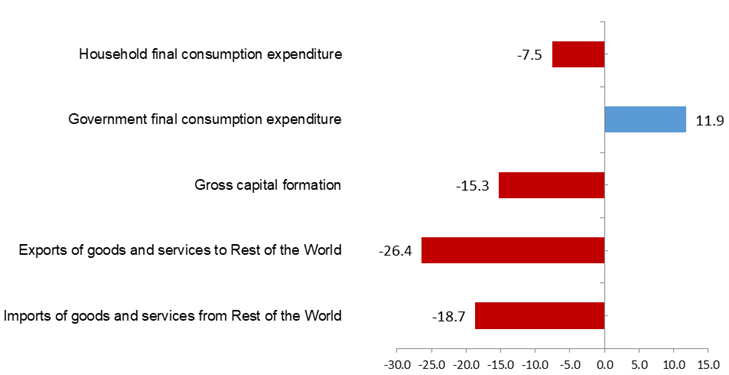
Real per capita HFCE or the household spending of every person declined by 8.9 percent in 2020. The real per capita HFCE in the region was recorded at Php 103,541 in 2020, lower than the national level which amounted to Php 118,723.
Per Capita Household Final Consumption Expenditure,
Philippines and Davao Region, 2020
At Constant 2018 Prices, in Pesos
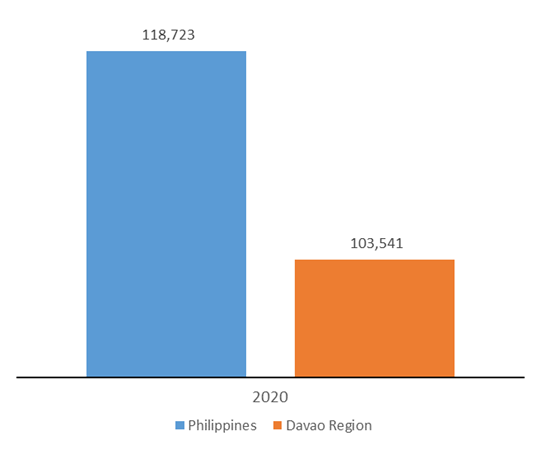
REGION XII - SOCCSKSARGEN [back to top]
SOCCSKSARGEN’s economy contracts by 4.3 percent in 2020
The economy of SOCCSKSARGEN contracted to 4.3 percent in 2020 from 3.5 percent in 2019 as both Industry and Services suffered reversals. The largest contractions were recorded in Other services, at -44.6 percent; Transportation and storage, at -35.2 percent; and Accommodation and food service activities, at 34.5 percent.
SOCCSKARGEN, Growth Rates by Industry: 2019 -2020
At Constant 2018 Prices, in percent

Services, which contributed 46.2 percent to the regional economy, contracted by 8.9 percent in 2020. Industry, with a share of 28.8 percent, dropped by 1.3 percent, as Construction and Manufacturing both contracted by 14.7 percent and 2.7 percent, respectively.
Industry and Services have the biggest contribution to the economic contraction of SOCCSKSARGEN Region, pulling down the growth by a total of 4.6 percentage points, while Agriculture, forestry, and fishing contributed 0.4 percentage point to the region’s economy.
SOCCSKSARGEN’s household spending drops
SOCCSKSARGEN’s Household final consumption expenditure, the main driver of the regional economy, dropped by 7.9 percent as restrictions on movement, curfew and granular lockdowns affected household income and spending during the pandemic. Gross capital formation slid further by 9.6 percent. Total Exports of goods and services to Rest of the World (ROW) contracted by 1.9 percent while total Imports of goods and services from ROW slumped by 11.9 percent. Only Government final consumption expenditure grew by 10.1 percent.
SOCCSKARGEN, Growth Rates by Expenditure Type: 2019 -2020
At Constant 2018 Prices, in percent
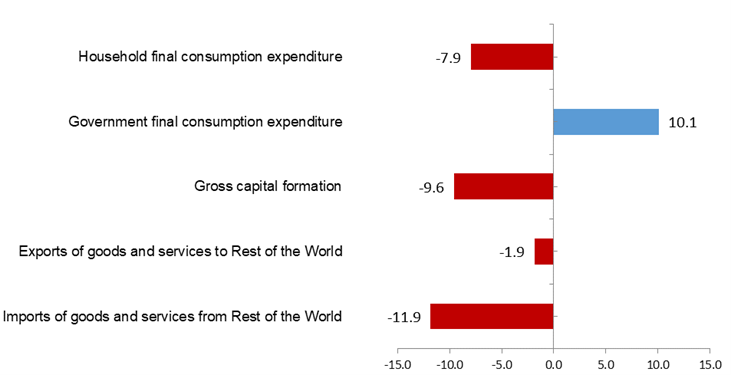
The real per capita HFCE in the region was estimated at P83,340, about 9.2 percent lower than the P91,779 recorded in 2019. It is about P35,382 lower than the national average of P118,723.
Per Capita Household Final Consumption Expenditure,
Philippines and SOCCSKARGEN, 2020
At Constant 2018 Prices, in Pesos
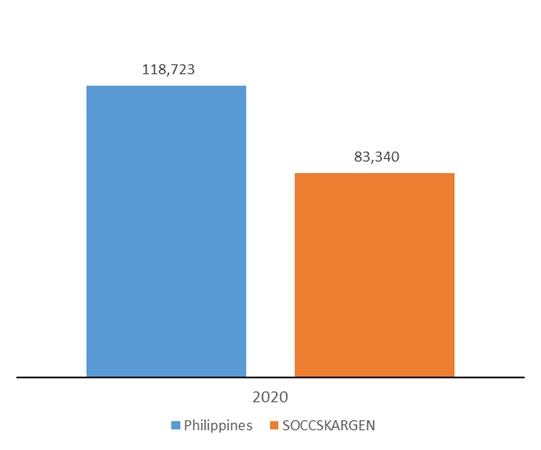
REGION XIII - CARAGA [back to top]
Caraga’s economic performance drops by 7.2 percent in 2020
The economy of Caraga dropped by 7.2 percent in 2020 compared with the 5.4 percent growth in 2019. The top three contributors to decline in 2020 were Construction, at -32.9 percent; Transportation and storage at -26.8 percent; and Mining and quarrying at -11.5 percent.
Agriculture, forestry, and fishing (AFF) grew by 3.9 percent in 2020 from a contraction of 3.6 percent in 2019. AFF contributes 14.3 percent to the regional economy.
Caraga Region, Growth Rates by Industry: 2019 -2020
At Constant 2018 Prices, in percent
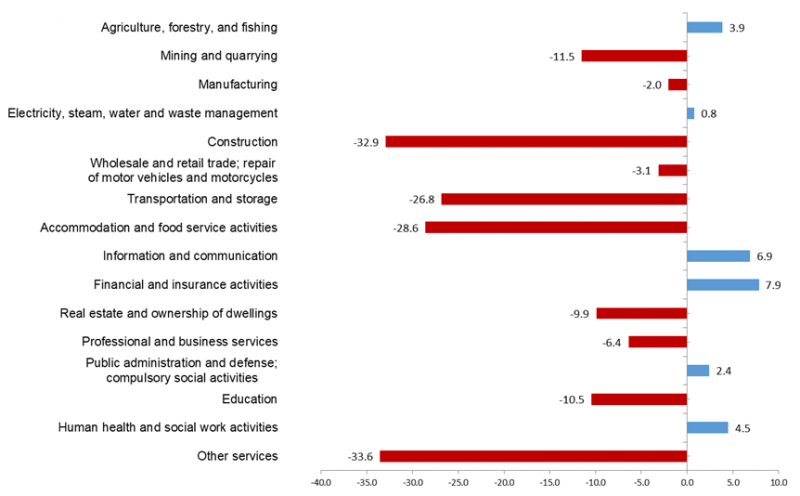
Of the 9.6 percent economic contraction in the country, Caraga’s contribution to the decline was estimated at -0.1 percentage points while accounting for 1.6 percent share of the total Gross Domestic Product (GDP).
Caraga posts a positive growth for the GFCE in 2020
Caraga posted a positive growth for the Government final consumption expenditure (GFCE) in 2020. All other expenditure items registered declines. Imports of goods and services from Rest of the World posted the largest decline of 33.4 percent. Likewise, Gross capital formation dropped by 27.9 percent, contributing 8.9 percentage points to the decline of the region’s expenditure. Meanwhile, household spending in the region, accounted to 74.6 percent of the region's economy, declined by 7.8 percent in 2020.
Caraga Region, Growth Rates by Expenditure Type: 2019 -2020
At Constant 2018 Prices, in percent
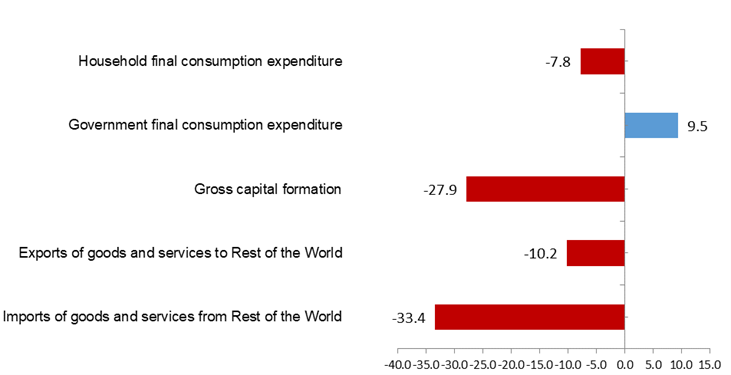
The per capita Household final consumption expenditure (HFCE) of Caraga declined by 8.8 percent, higher than the national per capita HFCE decline of 9.2 percent.
Per Capita Household Final Consumption Expenditure,
Philippines and Caraga Region, 2020
At Constant 2018 Prices, in Pesos
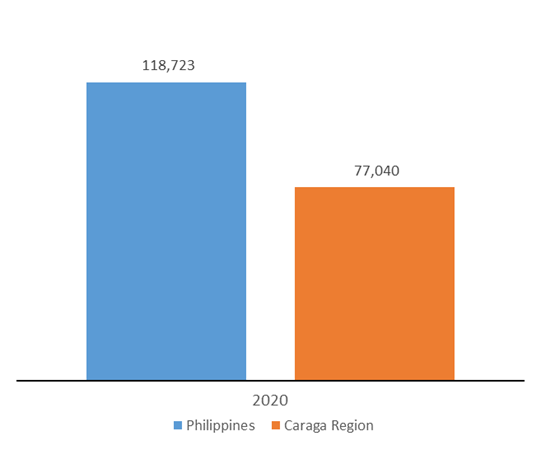
BARMM - BANGSAMORO AUTONOMOUS REGION IN MUSLIM MINDANAO [back to top]
BARMM’s economy contracts the least among all regions at -1.9 percent in 2020
The economy of the Bangsamoro Autonomous Region in Muslim Mindanao (BARMM) declined by 1.9 percent in 2020, the smallest decline among all the 17 regions. Major contributors to the decline were: Transportation and storage at -20.9 percent; Mining and quarrying at -54.7 percent; and Construction at -37.5 percent. On the other hand, top industries that contributed positively were: Financial and insurance activities at 14.8 percent; Human health and social work activities at 11.8 percent; Information and communication at 8.4 percent; Electricity, steam, water and waste management at 6.7 percent; and Public administration and defense; compulsory social activities, at 3.5 percent.
Bangsamoro Autonomous Region in Muslim Mindanao, Growth Rates by Industry: 2019 -2020
At Constant 2018 Prices, in percent
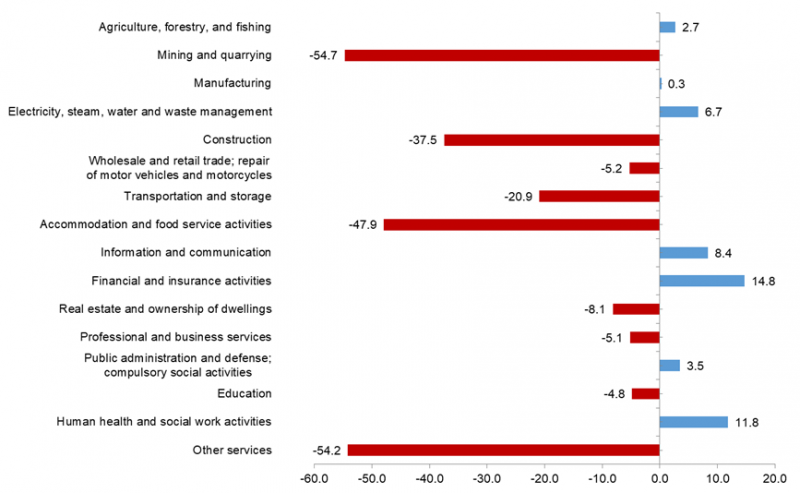
Agriculture, forestry and fishing (AFF) posted 2.7 percent growth and contributed the most to the regional economy of 0.9 percentage point, while Industry and Services contributed -1.0 percentage points and -1.9 percentage points respectively. In terms of share, Services had the biggest share to the region’s economy at 39.2 percent, followed by AFF at 36.2 percent, and Industry at 24.6 percent.
Accounting for 1.4 percent of the total GDP of the country, BARMM contributed only 0.02 percentage point of the total 9.6 percent contraction in the country’s economy in 2020.
BARMM’s HFCE and Gross capital formation contributes to the decline
BARMM’s Household Final Consumption Expenditure (HFCE) declined by 6.4 percent while Gross Capital Formation declined by 47.2 percent, contributing the most to the decline of BARMM’s economy. On the other hand, on the Government final consumption expenditure (GFCE) recorded positive rate of 11.3 percent.
Bangsamoro Autonomous Region in Muslim Mindanao, Growth Rates by Expenditure Type: 2019 -2020
At Constant 2018 Prices, in percent
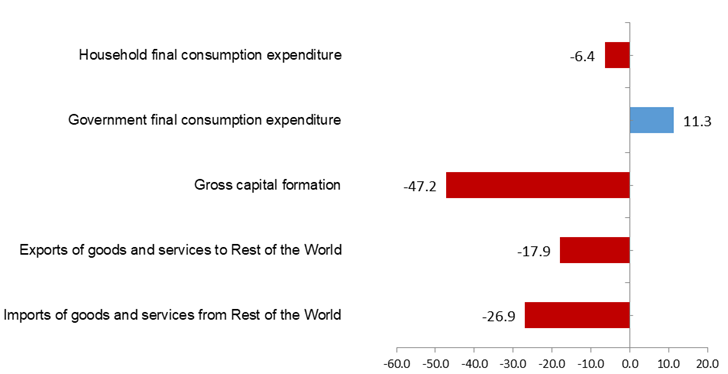
In 2020, BARMM’s per capita was the smallest decline among all other regions. It was estimated at Php 51,736, down by 3.9 percent from the previous year’s record of Php 53,825. In addition, the per capita HFCE in the region declined by 8.3 percent at Php 59,783. This was 49.6 percent lower than the national average of Php 118,723.
Per Capita Household Final Consumption Expenditure,
Philippines and Bangsamoro Autonomous Region in Muslim Mindanao, 2020
At Constant 2018 Prices, in Pesos
